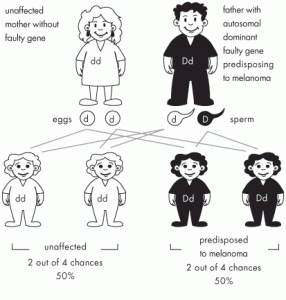
It is estimated that 10% of melanomas are associated with familial or inherited syndromes, Melanoma has a hereditary autosomal dominant transmission pattern and only genetic tests can determine whether a person has a genetic mutation. If you have a parent or sibling with melanoma, your risk of developing melanoma is two to three times greater than the average person .The co-existence of melanoma and atypical nevi within families has been described and the syndrome has therefore been named Familial Atypical Multiple Mole-Melanoma (FAMMM).
Mutations CDKN2A (p16, p14ARF eMST1) in are the most common cause of inherited melanoma and is believed to be linked to 25% of hereditary melanoma. This tumor suppressor gene encodes proteins that reduce cell growth These mutations, however can also appear in non-inherited cases of melanoma. Since 70% of people who have mutations in the CDKN2A gene will develop melanoma during their lifetime. All patients with CDKN2A mutation should be subjected to monthly analysis of the moles
Variations in MC1R (melanocortin-1 receptor) have a higher risk to develop melanoma in their life. People who have dark skin and who has more variations of MC1R has a higher than average risk for melanoma.
MDM2 genetic variant appears seems to predispose women to develop melanoma at a younger age
p16 mutations are the most common cause of inherited cancer risk in families with melanoma and pancreatic cancer. Anyone with the inherited gene mutation in the p16 is at higher than average risk for melanoma
There are also some genetic diseases associated with an increased risk of having a melanoma melanoma-astrocytoma syndrome, xeroderma pigmentosum, retinoblastoma, Li-Fraumeni syndrome, the ataxia telangiectasia and Werner’s syndrome, hereditary ovarian and breast cancer, Cowden’s syndrome.
Bibliography
Hansen CB, Wadge LM, Lowstuter K,Boucher K, Leachman SA. Clinical germline genetic testing for melanoma. Lancet Oncol 2004;5:314-319.
Somoano B, Niendorf KB, Tsao H. He reditary cancer syndromes of the skin. Clin Dermatol 2005;23:85-106.
Ghiorzo P, Scarra GB. Genetics of melanoma susceptibility. Forum (Genova) 2003;13:114-122.
Begg CB, Orlow I, Hummer AJ, et al. Lifetime risk of melanoma in CDKN2A mu tation carriers in a population-based sample. J Natl Cancer Inst 2005;97:1507-1515.
The Breast Cancer Linkage Consortium. Cancer risks in BRCA2 mutation carriers. J Natl Cancer Inst 1999;91:1310-1316.
Rieder H, Bartsch DK. Familial pancre atic cancer. Fam Cancer 2004;3:69-74.
Riedijk SR, De Snoo FA, Van DijkS, et al. Hereditary melanoma and predic tive genetic testing: why not? Psychooncology 2005;14:738-745.
de Snoo FA, Bergman W, Gruis N. Fa milial melanoma: a complex disorder leading to controversy on DNA testing.Fam Cancer 2003;2:109-116.
Geno MEL: The Melanoma Genetics Consortium. Physician information. Available at: www.genomel.org. Accessed January 25, 2006.
Tsao H, Niendorf K. Genetic testing in hereditary melanoma. J Am Acad Dermatol 2004; 51:803-808.
Familial malignant melanoma